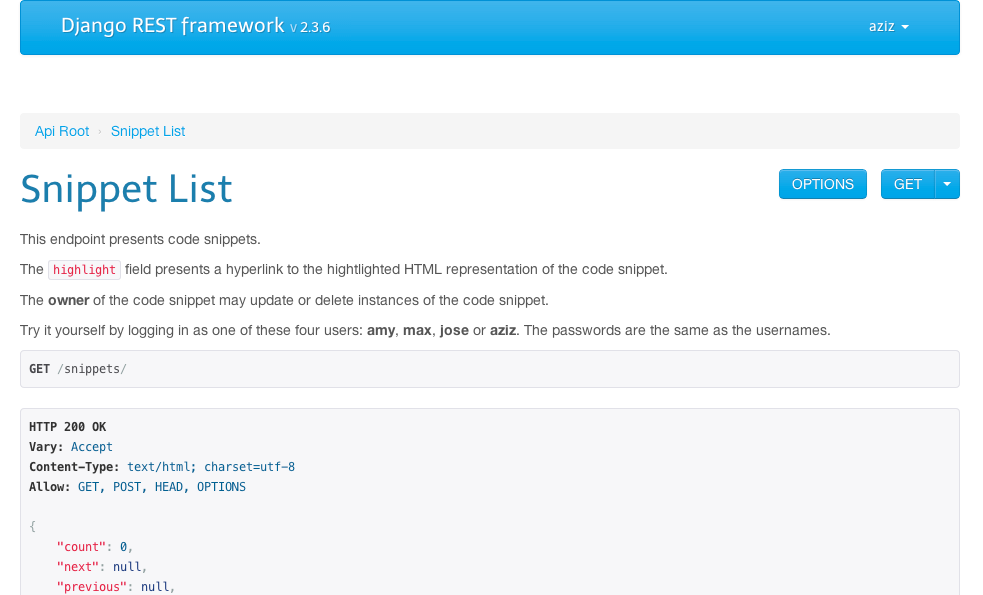Django REST framework -- Authentication & Permissions
Authentication & Permissions
https://www.django-rest-framework.org/tutorial/4-authentication-and-permissions/
对于view需要限制用户的访问权限, 例如认证 和 许可。
Currently our API doesn't have any restrictions on who can edit or delete code snippets. We'd like to have some more advanced behavior in order to make sure that:
- Code snippets are always associated with a creator.
- Only authenticated users may create snippets.
- Only the creator of a snippet may update or delete it.
- Unauthenticated requests should have full read-only access.
Adding information to our model
https://www.django-rest-framework.org/tutorial/4-authentication-and-permissions/#adding-information-to-our-model
在snippet模型中,添加 owner 和 highlighted field。
owner = models.ForeignKey('auth.User', related_name='snippets', on_delete=models.CASCADE) highlighted = models.TextField()
引入 高亮代码 工具
from pygments.lexers import get_lexer_by_name from pygments.formatters.html import HtmlFormatter from pygments import highlight
在创建snippet 序列化类中, 添加save函数, 保存高亮后的结果。
def save(self, *args, **kwargs): """ Use the `pygments` library to create a highlighted HTML representation of the code snippet. """ lexer = get_lexer_by_name(self.language) linenos = 'table' if self.linenos else False options = {'title': self.title} if self.title else {} formatter = HtmlFormatter(style=self.style, linenos=linenos, full=True, **options) self.highlighted = highlight(self.code, lexer, formatter) super(Snippet, self).save(*args, **kwargs)
Adding endpoints for our User models
https://www.django-rest-framework.org/tutorial/4-authentication-and-permissions/#adding-endpoints-for-our-user-models
在用户的序列化类中, 添加此用户对应的所有 snippets的主键field。
from django.contrib.auth.models import User class UserSerializer(serializers.ModelSerializer): snippets = serializers.PrimaryKeyRelatedField(many=True, queryset=Snippet.objects.all()) class Meta: model = User fields = ['id', 'username', 'snippets']
用户的view定义
from django.contrib.auth.models import User class UserList(generics.ListAPIView): queryset = User.objects.all() serializer_class = UserSerializer class UserDetail(generics.RetrieveAPIView): queryset = User.objects.all() serializer_class = UserSerializer
Associating Snippets with Users
https://www.django-rest-framework.org/tutorial/4-authentication-and-permissions/#associating-snippets-with-users
在SnippetList视图中, 在创建函数中, 将当前用户保存为 owner字段。
def perform_create(self, serializer): serializer.save(owner=self.request.user)
Updating our serializer
https://www.django-rest-framework.org/tutorial/4-authentication-and-permissions/#adding-required-permissions-to-views
在SnippetSerializer中,添加owner为只读声明。
Now that snippets are associated with the user that created them, let's update our
SnippetSerializerto reflect that. Add the following field to the serializer definition inserializers.py:
owner = serializers.ReadOnlyField(source='owner.username')
Adding required permissions to views
https://www.django-rest-framework.org/tutorial/4-authentication-and-permissions/#adding-required-permissions-to-views
在视图中 ,添加许可声明。
Now that code snippets are associated with users, we want to make sure that only authenticated users are able to create, update and delete code snippets.
REST framework includes a number of permission classes that we can use to restrict who can access a given view. In this case the one we're looking for is
IsAuthenticatedOrReadOnly, which will ensure that authenticated requests get read-write access, and unauthenticated requests get read-only access.First add the following import in the views module
from rest_framework import permissions
Then, add the following property to both the
SnippetListandSnippetDetailview classes.
permission_classes = [permissions.IsAuthenticatedOrReadOnly]
permissions
https://www.django-rest-framework.org/api-guide/permissions/#api-reference
AllowAny
The
AllowAnypermission class will allow unrestricted access, regardless of if the request was authenticated or unauthenticated.This permission is not strictly required, since you can achieve the same result by using an empty list or tuple for the permissions setting, but you may find it useful to specify this class because it makes the intention explicit.
IsAuthenticated
The
IsAuthenticatedpermission class will deny permission to any unauthenticated user, and allow permission otherwise.This permission is suitable if you want your API to only be accessible to registered users.
IsAdminUser
The
IsAdminUserpermission class will deny permission to any user, unlessuser.is_staffisTruein which case permission will be allowed.This permission is suitable if you want your API to only be accessible to a subset of trusted administrators.
IsAuthenticatedOrReadOnly
The
IsAuthenticatedOrReadOnlywill allow authenticated users to perform any request. Requests for unauthorised users will only be permitted if the request method is one of the "safe" methods;GET,HEADorOPTIONS.This permission is suitable if you want to your API to allow read permissions to anonymous users, and only allow write permissions to authenticated users.
The Browsable API
https://www.django-rest-framework.org/topics/browsable-api/#urls
https://www.geeksforgeeks.org/?p=563823
API may stand for Application Programming Interface, but humans have to be able to read the APIs, too; someone has to do the programming. Django REST Framework supports generating human-friendly HTML output for each resource when the
HTMLformat is requested. These pages allow for easy browsing of resources, as well as forms for submitting data to the resources usingPOST,PUT, andDELETE.




